Bruce Sedley was a well-known Bay Area children’s television personality in the 1950’s and 1960’s. Before that, he appeared on several local radio stations. He died in 2012 at age 86. He originally wrote the following autobiographical piece for the National Academy of Television Arts and Sciences San Francisco/Northern California Chapter, where he was enshrined in the organization’s Silver Circle.
Perhaps I was destined for “show-biz” as my father had two daughters during his first marriage. One of them married Jack Warner who founded Warner Brothers Studios; the other married a San Francisco owner of some movie theaters.
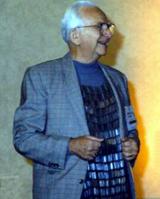
I grew up in Berkeley, California, attending various elementary schools. Then came 1941 and World War II. Mother became a driver for the officers at the Presidio in San Francisco and we were moved at Army expense to Salt Lake City where she became a driver at Fort Douglas. I attended East High, became lead actor in the 1942 class play “The Man Who Came To Dinner” (and to get the part bought elevator shoes so I would be tall enough, but during the entire play I was in a wheelchair playing the role of “Sheridan Whiteside”).
After high school, we returned to San Francisco and I took speech lessons from a lady in San Francisco and she got me a part-time job at KJBS, a local radio station, announcing the “Wells Fargo Music Hour,” a nightly classical music program, from April 1945 to April 1946. Then I received notice that my draft number had been called.
A friend at KJBS pulled some strings, and just before I was to ship out my orders were changed and I was directed to report to the Armed Services Radio Service in Hollywood. There, from studios on Santa Monica Avenue, I broadcast news and introduced transcribed recorded programs taken from live broadcasts with the commercials removed. These were beamed to troops on ships and in remote locations in the various war zones.
We did “Dictation Speed News,” which was a five-minute newscast read very slowly for 15 minutes, repeating each line twice so that it could be taken down by hand by service personnel on ships and in remote camps. They would then post the news, or re-broadcast it.
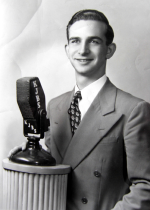
I was discharged in May 1947 and returned to San Francisco. The next day I got a phone call from KTIM, a radio station in San Rafael in Marin County, that had just gone on the air. They had started using their chief engineer as announcer but he was not satisfactory. I got the job.
One year later, in May of 1948, I auditioned at KROW in Oakland (later called KABL), and became a staff announcer and disc jockey. Eventually, I had my own show, a morning wake-up show called “Nick and Noodnick,” where I replaced the original “Noodnick” — Don Sherwood, who later became a legend in San Francisco radio.
Others at the station from time to time were Phyllis Diller who went on to TV and movie fame as a comedienne, getting her break on the Jack Paar show; Rod McKuen, the young boy poet, had a weekly show; Jack Clark, a student at U.C. Berkeley, went on to become a game show host in New York; David Sacks, the sales manager, partnered with Bing Crosby to produce multi-media shows in various big cities — “San Francisco Experience,” “Hawaii Experience,” etc. He became GM of a San Francisco network station, KGO-TV; and Russ Coughlin, the KROW Production Manager, became GM of ABC and a well-known newscaster.

At KROW, a late-night spot opened from 11 p.m. to 2 a.m., and I was given it for “Sedley’s Medleys.” It was great fun and the program became very popular. But I was a poor disc jockey who could never remember the name of the record or the artist so I invented voice “friends” and developed them into personalities.
One that I had started at KTIM was “Professor Eustace Beauregard Fuddle,” the weather forecaster who was never right. “Professor B. Fuddle” caught on, and he became more important in the program as time went on. Other characters were developed, and soon I was in demand to do voices for TV spots, and animated films. I stayed at KROW for five years until December of 1952.
At one time I did stand-up comedy in nightclubs using my 1/8-size violin to do an act. A friend was a portrait photographer, J. Arthur McMurray. Together we produced a weekly TV spot called “Can You Name This?” We used a 16mm camera and each week took a shot of some public monument in the area, like a statue in the park. Then I would splice this shot into the original footage of the rest of the 30-second film spot, make the audio tape narration and record it on a disc and then drive up to the transmitter site of KGO-TV on the top of Sutro Heights where I would deliver the film and disc to the engineer.
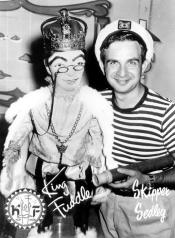
He would splice the film into the big roll of film used for the day, and when our spot was playing, he started the audio disc on a turntable. Later I would drive back up and retrieve the film and we would splice in another original shot for the next week. People that wrote in correctly identifying the mystery subject won a free sitting for a portrait, and J. Arthur McMurray did very well as everyone wanted additional pictures which they paid for.
My radio work left time during the day for other activities. I opened a recording studio. One of my clients was an advertising company that had the account of the Sylvester Butter and Eggs Company whose logo was a fat little jolly man called, imaginatively, “Mr. Sylvester.” I gave him a voice like Ed Wynn, and the agency sponsored a weekly TV puppet show on KRON with marionettes dancing and singing to records. To do the manipulation and supply the marionettes, Ray and Dorothy Daudelin of Alameda were brought in and they produced wonderful marionettes of Bing Crosby, Dinah Shore, Lena Horne, the Andrews Sisters, Groucho Marx, and they had a stable of a hundred more they had made over the years.
The “Mr. Sylvester Show” ran for many months. I would record the scripts using various voices, transcribe it to large transcription discs that turned at 33-1/3 rpm, take the disc to the TV station and Mr. Sylvester would air with live cameras and recorded audio. When the show became popular, I suggested to the client that they make up hand puppets of Mr. Sylvester and give them as premiums with the butter and eggs. They said, “OK, you do it.” I proceeded to have 10,000 paper pulp heads molded, hand-painted by a doll company that also made the puppet mitts and connected them to the heads. The promotion was a great success. I had never realized how many 10,000 of anything was.
I left KROW in December of 1952 to join Gene Walker Productions, a San Francisco film documentary firm, as a recording engineer. His photographer was Russ Meyer, who later would become famous for Hollywood films of busty women long before nudity in films was considered acceptable.
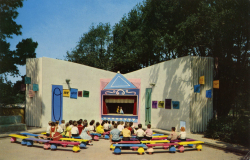
One day at Gene Walker’s, an old man named Al Dinsdale came in with a scrapbook showing various dioramas he had built for Wells Fargo Bank Museum to tell the story of the Pony Express. He wanted to know if we ever needed miniature sets. While leafing through his book I saw pictures of a girl and a ventriloquist dummy. He said it was his daughter Shirley Dinsdale who was in New York on television using the dummy he had made that she called “Judy Splinters.” I mentioned that while on radio I had invented a character called “Professor Eustace Beauregard Fuddle” who gave the weather reports on the program and had a funny voice. I asked Al if he could make me a “Professor B. Fuddle” vent figure.
A few days later he came back holding a head that was very realistic. Al said the head had been made years before so he reworked it so the mouth would look like mine and go with the Professor’s voice. I was very pleased and asked if he could make the body. He said he had one, and soon returned with a body in a white sailor suit, the torso was a kitchen pot with hinges for the cloth arms and legs. The hands had springs to connect each finger to the palm as Al said children should feel movement when they shook hands.
I was thrilled and offered to pay for the figure but Al would not accept anything. I took the figure home and had no idea how to use it. I went back to the doll company that had made the Sylvester puppets and the woman owner made a cute little gray pinstriped three-piece suit with gray cravat. Then I took the head to a local wig company and found out that many people who wear hair pieces leave them to wig companies when they pass on, and the wig companies make them available to morticians for improving the looks of badly disfigured bodies. One of these wigs, a size 7, fit Fuddle beautifully with no changes. I bought it for $25.00 and had the wig company make eyebrows for the head also. When he was dressed up, he looked so realistic my mother could not stand the unblinking eyes looking at her at home and insisted on covering him with a pillowcase.
Then I heard of an audition for a TV commercial for Laura Scudder Potato Chips that was to be done live once a week on KGO-TV. I went with the “Professor” and won the job but I had no idea how to “throw” my voice. The commercials aired for many weeks and the director cleverly kept the camera off of me when the puppet was talking. At night I would practice in front of a mirror and got books on ventriloquism to try to learn it. I could never have the puppet say anything with the sound of “B” or “P” in it. Fortunately, as I wrote my own copy, I could try to keep these sounds out of the words.
Later as I ad-libbed with the puppets, I tried to select words I could say easily. It was not very successful. I found that most good ventriloquists were so enamored of their skill that they would look at the audience when the puppet was talking. I always looked at the puppet to direct attention to him, and in so doing my lips were not facing the audience.
In April of 1953 I was asked to return to KROW and gladly did so, staying there another four years until 1957. During those years at KROW, I was working on other ideas. I had met some men in the Safety Division of the Oakland Police Department who were charged with coming up with a program to teach safety to school children at assemblies at their schools.
I worked out an act using the Professor and other puppets, and a “Helme-tron” hat that had an electric rotor blade on top, and a train track around the rim. It was the “Train of Thought.” I had found a clear plastic bubble lens, used over lights on aircraft, that made a suitable hat and fitted this with the gadgets including a toy electric crane hanging down in front that raised and lowered a kitchen potato masher which I called the “microphone” which was used to “ask” the Hat questions.
The control box with its batteries hung around my neck so I could reach the switches that turned on the effects. The kids loved the Professor and the Hat, and we always met all the children at the end of the assembly and let them shake the Professor’s hand.
The school program went for two years and resulted in the setting up in March of 1956 of A.V.I.D. Enterprises which stood for “Audio-Visual Idea Development Enterprises.” After leaving KROW I devoted full time to AVID, doing voices and recording and TV production.
In 1957, the Oakland Park Department was building a theme park called Children’s Fairyland in beautiful Lake Merritt Park. The genius behind the project was William Penn Mott, the director of the Oakland Park Department, who a few years later would become the Director of the National Parks of the United States. To get the children’s interest he had installed record playing machines operated by five-cent coins at the sets to play musical nursery rhymes, but the units were always breaking down.
As I was familiar with tape playback message repeaters, I was called in and suggested that they use them and that instead of a coin, sell the children a lifetime “Magic Key to Fairyland,” a gold-plated ornamental plastic key that could be inserted into a keyhole in post-mounted “Talking Storybooks” at each set. Bill Mott accepted the proposal, a contract was signed, and the Park Department made and installed the first “Talking Storybooks” in the fall of 1958.
The previous year, KRON-TV in San Francisco was losing viewers to the “Mickey Mouse Club” on another channel. Some stations had found that the old “Popeye” cartoons had such appeal that they beat the Mickey Mouse Club ratings, so KRON had purchased the Popeye films and was looking for a host for a nightly hourly program featuring them opposite the Mickey Mouse Club. I won the audition with my puppets.
 Due to my association with Fairyland, I changed “Professor Fuddle” into “King Fuddle of Fairyland,” and offered Bill Mott to promote Fairyland on my program if he would let me appear there on the
Due to my association with Fairyland, I changed “Professor Fuddle” into “King Fuddle of Fairyland,” and offered Bill Mott to promote Fairyland on my program if he would let me appear there on the
weekends to meet the children. He agreed and gave me a contract for the appearances. It was only natural when the “Magic Keys” were introduced that I promoted them heavily on the air, did TV remotes from Fairyland, gave away the keys as prizes, and worked many of the sets, characters, and promotions of Fairyland into the show.
As a result, when the “Talking Storybooks” were introduced they were an instant hit, and the combination of the TV and the public appearances in Fairyland brought me so many requests for public appearances that I hired an agent, Milton Levy Jr., to negotiate for me. We changed the name of the company to Audio Tours, Inc., and looked around for some other project for the Talking Storybooks, on which I had applied for a patent. The obvious choice was the San Francisco Zoo.
Armed with the sales figures (and the promotional opportunity of free TV time), the “Friends of the Zoo” eagerly agreed to my contract to install the system throughout the Zoo absolutely free, on the same conditions as at Fairyland. I would make them a new key, however, an elephant-shaped key with the trunk straight out which became the part to insert into the Talking Storybook keyhole. So “Trunkey the Elephant” was born, and in 1959 the 41 Storybooks in the Zoo were operational.
So many keys were now required that I hired local housewives to assemble the colorful tags on the keys and either box them for Fairyland or put them on large peg boards by the hundreds for the Zoo. The pressure of the business and my tardiness at showtime at KRON caused the station to terminate my Skipper Sedley program in September of 1959 but I was so busy with the Storybooks it made little difference to me except for hurt pride, but I needed the freedom to travel.
Milt and I went to Kansas City and showed the idea at a Trade Show of the National Parks Association. We ended the show with three or four signed contracts and during 1960 and 1961 we installed the system in over 20 major zoos in the United States, including the Bronx Zoo in New York.
The Seattle World’s Fair was scheduled to open in 1962. Audio Tours won the contract to provide individual tape recorder playback machines for the American Express company’s “Tour of the Science Exhibit of the United States.” In addition, we were to install coin-operated Storybooks around the railing of the Space Needle. Throughout the fairgrounds there would be Storybooks operated by the “Key to the Fair,” a plastic gold-plated decorative medallion key.
I agreed to place at each entrance a free push-button box that would contain a personal greeting from the President of the United States, John F. Kennedy, who was unable to come to the Fair. The recording was arranged by his press secretary, Pierre Salinger, who had been a reporter for the Chronicle and was one of my family relatives, and the system opened on schedule.
Then in November of 1962, I heard that KTVU (Channel 2) was looking for a host for the daily one-hour “Three Stooges Program.” I won the audition and became “Sir Sedley,” with “King Fuddle and his Friends.” We re-established our contact with Fairyland, and the program again was successful.
Although the Stooges films had much funny violence that parents were certain would scar their children, it was very popular. Weekends, I did public appearances at supermarkets and shopping centers with all my puppet friends.
The Three Stooges were three old men, Larry, Moe, and one other from time to time imitating the original “Curly,” who had passed away. The Stooges had not made a dime on the old films that were showing on TV, so when they found themselves popular again they decided to capitalize on it and, through Columbia Pictures, they made a full-length film each year that they shared in the profits.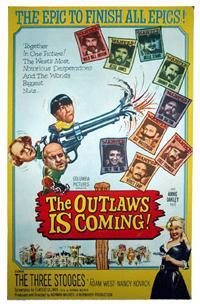
One year they had a brilliant thought: make a movie that all the TV show hosts of all the Stooges programs in the USA could take a tiny part in, then they would all go home and promote the picture on their local stations. I received an invitation to bring my wife to Hollywood for a week and be in a Stooges picture all expenses paid, a small token salary also … plus residuals. Naturally, I accepted, as did about ten other hosts from around the country.
We were put into the Hollywood Roosevelt Hotel and the shooting was done at the Burbank Studios. It was great fun but a terrible picture. In it, as the hero was Adam West, who went on to become Batman, and Nancy Kovack, who did fairly well after that. The story was that the outlaws of the old west were called to help a crony who was trying to take over a town.
Each TV host became one of the outlaws; I was Cole Younger. There was Doc Holliday, Billy the Kid, Belle Starr, Jessie James, Wyatt Earp, and some others. Each of us did a cameo scene about getting the phone call to come to help, then when we were all there, the Stooges did their thing to foil our plans.
At the end we were routed and kicked out of town, as well we should have been. Columbia sent each of us clips of our performances which we all promoted on our programs, and in spite of its terrible plot, it did OK for the Stooges. The movie was called “The Outlaws Is Coming.” Miss it if you can.
The power of TV to influence children was demonstrated to me after I asked King Fuddle if I could have a Coat of Chain Mail. He said no, so I said I would make one myself. I asked the children to each send me one
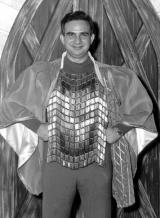
paper clip. In a day or so, we had 50,000 or more clips, some children dumping a box of clips in an envelope and mailing it in.
The post office was furious as the clips damaged their stamp canceling machines. A day later I announced I had plenty of clips and please don’t send any more. I stayed up nights watching Johnny Carson and making the chain mail vest. When finished it weighed 15 pounds. I wore it for every personal appearance since that time and when a child said he or she had sent in a paper clip I would select one and say … here it is! The vest hangs in my closet today.
As the KTVU television program was at 4 p.m. weekdays, I had almost a full day available for other things. I joined the advertising agency of Cappel, Pera and Reid in Orinda California in March of 1963. My accounts included Red’s Tamales, for which I coined the slogan “Tuesday is Red’s Tamale Day” which used that line spoken by Mel Blanc in commercials for years after.
The agency specialized in food accounts and was considered very creative and successful. One client was Morrell Meats. They hired a local 7’2″ giant named Richard Kiel who was selling cars in Hayward. To promote their packaged meats they called him “Big Frank” and they bought spots on my program which we did live together. We were quite a team as I strained to reach 5’6″. After that auspicious start, Richard went on to become famous as “Jaws” in the James Bond films.
I stayed with the agency until February 1965. The year before, in December of 1964, KTVU decided to replace the live host kid shows with a packaged teenage dance show and the Stooges were terminated.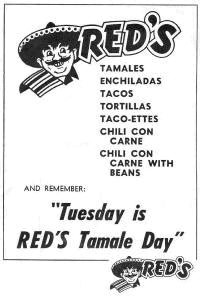
After leaving the advertising agency, I associated with Thomas J. Cox who had an audio-visual equipment company in San Francisco. Tom made multi-media projector devices. Together we decided to re-activate the “Talking Storybooks” but instead of using wired electric power to the tape playback machines we would use a battery-powered message repeater. Instead of the plastic key (which was always breaking off in the key slot) we would use a plastic card, and instead of it being usable for a “lifetime” we would make it the membership card in the Zoo association, and it would be replaced yearly and the code of the card-operated switch lock to turn on the message would be changed yearly also.
First I contacted Cardkey Systems in Burbank, Calif., which made a card lock operated with a paper card. They agreed to sell me a card lock for $25.00 each and the cards for 25 cents each. As this was close to what we planned for our selling price, I decided to try to design a less expensive card lock and card. In a magnet store in San Francisco, I came across a new flexible rubber material called “Plastiform.” It could be magnetized, but it was too thick for a card. I experimented at home in the kitchen making formulations of the main component, barium ferrite powder, with various liquids that would hold the powder in suspension.
In the North Beach area of San Francisco, I bought a noodle maker, which combined a crank handle with two steel rollers used to make thin dough. I mixed the materials in an antique brass mortar and pestle, squeezed it into thin sheets with the noodle maker, put strips in the toaster oven to heat or vulcanize, and then tried to magnetize it. It made our kitchen filthy but the material was not too bad. I was able to make it work a card lock that contained magnet pins to form the code. I later obtained a patent on the lock and the magnetic card. We installed the new audio system called “Explainettes” in Oakland’s Knowland Park Zoo. The card became the membership card for the “Friends of the Zoo.” It worked pretty well. We sold the system to other zoos for a year or so.
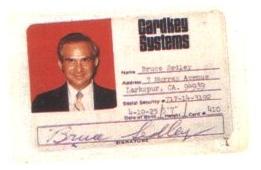 Then Cox and I decided to sell the Explainette System. In talking to prospective buyers we realized that there was more interest in the card lock and the magnetic card than the audio system. I went to see Cardkey Systems in Burbank and offered them the audio system and the new magnetic card and card lock. They bought them and in 1965 asked me to join the company to develop the devices.
Then Cox and I decided to sell the Explainette System. In talking to prospective buyers we realized that there was more interest in the card lock and the magnetic card than the audio system. I went to see Cardkey Systems in Burbank and offered them the audio system and the new magnetic card and card lock. They bought them and in 1965 asked me to join the company to develop the devices.
They sent me to Mexico City for a Parks and Recreation Trade Show and we sold the system to some zoos but it was soon evident that the card and the card lock was where the money was and soon the tooling and stock of Explainette gathered dust and some years later they were thrown out.
The first commercial use of the new card was for the Democratic National Convention in 1968 in Chicago, scene of the confrontation with the police outside the Stockyards where the convention was held. The magnetic card system that we supplied to all persons authorized to enter the building helped to keep the disturbance off the convention floor.
I left Cardkey in 1974 to become their distributor in the San Francisco area, and shortly thereafter, while on a holiday in Hawaii, I had occasion to change the door lock on an apartment door. The front knob was removable and it occurred to me that if a small card lock could be made to fit on the lock in place of the original knob then it would be “card-operated”. I designed a replacement front knob and called it a “COR-KIT,” a Card-Operated-Replacement-Key-In-Tumbler Lock. A company called “CorKey Control Systems” was formed to sell the invention to locksmiths.
The business went well. I traveled to Europe and Asia setting up distributors and licensees. A Hong Kong company was formed in 1983 to become the factory. I moved to Hong Kong the following year and became the Managing Director of the company. King Fuddle came with me, but as he never learned to speak Cantonese, he wasn’t able to communicate with the children. I convinced him to replace his “king suit” with a Chinese high-necked shirt and a smoking jacket, but he molded away in the humidity, shut up in his dark damp black box.
In 1992 he was liberated when Forrest Patten, a good friend (and active member of NATAS) in San Francisco offered to give him a facelift and new wardrobe. Today, he is a new man, with beautiful features and a lovely new costume with Kelly Green robe.
Entertaining children is delightful; they are so receptive. I learned to be careful of small children in the toddler stage, however, as the strange movements of the very real-looking King Fuddle frightened them. I learned that if a toddler was being pushed forward to meet Fuddle I would close the King’s eyes. That always worked, as it was his real-looking glass eyes that confused and frightened the children. After he talked to them and then opened his eyes, it was usually okay.
I taught a class in ventriloquism at Children’s Fairyland and then spent a few years in Hawaii. There I reactivated my old act with King Fuddle and did a series of puppet shows at the public libraries. I was amazed that the children reacted to the puppets they had never seen before as much as the Bay Area children who saw them nightly on TV.
Through the years, King Fuddle has inspired love and affection in all that have had contact with him. He was a gift to begin with, a labor of love. He stood by me through various ventures, always being himself, not a cheeky wise-cracking vent “dummy.” I have never thought of him as such, and always let him be “himself.” To me, King Fuddle is a person with a personality all his own. It is my wish that he continues to entertain and meet people and spread his aura into their lives as he has done to mine.
This article originally appeared on the NATAS/Northern California website.
Reprinted by generous permission of the author, who also provided
photographs from his private collection for this presentation.
RELATED RESOURCES:
![]()

What fun to read about this great personality! I watched both Skipper Sedley and Sir Sedley when very young. I am surprised that there wasn’t/isn’t mention of Charlie the frog, or rather, Charl Farley the Frolfog. Yep- I still know the language as do a couple of former co-workers.
OMG…I remember Charl-farley the frol-fog too, and his lalfang-gualfage!!!
And, if it weren’t for your comment, I wouldn’t have remembered that it was from that hour of the Three Stooges (probably) that it came from. Oh, and that paper clip chain mail coat?!
YES; I remember that too. I don’t believe anybody who witnessed that would be able to forget it. LOL
Thank you, er, thalfank youlfu solfo mulfuch!
I remember watching Sir Sedley with the three stooges on KTVU channel 2. I watched it after school. 3rd, 4th and 5th grades. I think he would show the progress as he made the chain mail. I think he was replaced by the Paul Revere and Raiders Show. I also remember the story boxes and the elephant keys at the SF zoo, I had one that I saved for years, wish I still hade it. I had no idea that Sir Sedely played any part of that. This guy was awesome.
I remember Mayor Art too. A rival show, same time, on KRON channel 4? At the end he would say “I’ll be seeing you, subsequently.” Then ask kids in the live audience what that word meant.
Those were the days. Art Linkletter on the radio around noon. Captain Kangaroo in the morning.
Watched the shows living in Oakland. I was hoping to find some videos of the shows on the web, but not having any luck.
Really interesting. I’d never connected him with Zoo Keys until I read a recent bio online. I remembered the jingle — “”All the animals in the zoo/are jumping up and down for you…” — and found it on YouTube; turns out he was the singer on it. I remember him best as Skipper Sedley of the Kron-Tiki (the channel, of course, was KRON-TV), with regular guests Popo the Clown (with his magic words, “Ibbidy bobbidy boo, I love you”) and dog trainer LeRue Grim, who as it turned out was doing it to earn money for a law degree, which led him to a rather checkered career that ended with his getting disbarred at age 84. There was also Little Oscar of Wienermobile fame. The Thinkatron Hat with its Train of Thought, that always came up with the solution to his problem (except once, when Popo managed to outwit him anyway; that really annoyed me because I felt it violated the premise). One guest, I think during the last week or two of the show, who insisted on calling him Bruce instead of Skipper. Live commercials for a few weeks for a powdered juice drink (not Sonny Boy) that ended with a three-line jingle (middle line was “it’s real juice” and the last line listed the four flavors) which he sang while the engineers offstage played a taped accompaniment, except that the two were never in sync. When they finally did sync up one day I wrote him a letter congratulating him that he read on air. I’d have been about eight years old.